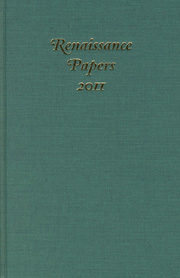Book contents
- Frontmatter
- Contents
- Dedication
- Walking, Waking, and the Armor of Light: Pauline Enactments in Henry IV, Part 1
- Costard's Revenge: Letters and Their Misdelivery in Love's Labour's Lost
- Productive Violence in Titus Andronicus
- Method in Marlowe's Massacre at Paris
- Ending Well: Mixed Genres and Audience Response in the London Theatrical Marketplace, 1604–06
- Birdlime: Sticky Entrapments in Renaissance Drama
- Sacrifice and Transcendence in Sir Philip Sidney's Astrophil and Stella
- The Quest for Certainty in Fulke Greville's A Treatie of Humane Learning
- Traces of the Masque in George Herbert's The Church
- Una Trinitas: Una and the Trinity in Book One of The Faerie Queene
- Reconsidering the 1599 Bishops' Ban on Satire
- Robert Bellarmine the Censor and Early-Modern Humanism
Method in Marlowe's Massacre at Paris
Published online by Cambridge University Press: 05 April 2013
- Frontmatter
- Contents
- Dedication
- Walking, Waking, and the Armor of Light: Pauline Enactments in Henry IV, Part 1
- Costard's Revenge: Letters and Their Misdelivery in Love's Labour's Lost
- Productive Violence in Titus Andronicus
- Method in Marlowe's Massacre at Paris
- Ending Well: Mixed Genres and Audience Response in the London Theatrical Marketplace, 1604–06
- Birdlime: Sticky Entrapments in Renaissance Drama
- Sacrifice and Transcendence in Sir Philip Sidney's Astrophil and Stella
- The Quest for Certainty in Fulke Greville's A Treatie of Humane Learning
- Traces of the Masque in George Herbert's The Church
- Una Trinitas: Una and the Trinity in Book One of The Faerie Queene
- Reconsidering the 1599 Bishops' Ban on Satire
- Robert Bellarmine the Censor and Early-Modern Humanism
Summary
In scene 4 of Christopher Marlowe's Massacre at Paris (1593), his dramatization of the St. Bartholomew's Day massacre of Protestants, which took place in 1572 and formed a central moment in the French wars of religion, Queen Mother of France, Catherine de Medici, asks the Duke of Guise: “What order will you set down for the massacre?” The Duke of Guise gives a typically smooth answer, detailing the “white crosses” and “white linen scarfs” to be worn by his men taking part in the massacre, and the “peal[s] of ordnance” that will mark the beginning and the end of the slaughter (4.30–39). In the very next scene we witness precisely that: Anjou, Dumaine, Retes, Gonzago, and Mountsorrell appear with “argent crosses” “to kill all that [they] suspect of heresy,” as cannon-fire signifies that the action has begun (5.1–3). The clockwork precision with which we see these events unfold in accordance with Guise's initial predications is not only chilling but also carried out with a swiftness that invites a dark comedy to preside over the macabre events that follow. Providing the foundations for this oddly decorous mass slaughter is the art central to all early modern intellectual modi operandi: logic.
- Type
- Chapter
- Information
- Renaissance Papers 2011 , pp. 41 - 52Publisher: Boydell & BrewerPrint publication year: 2012



